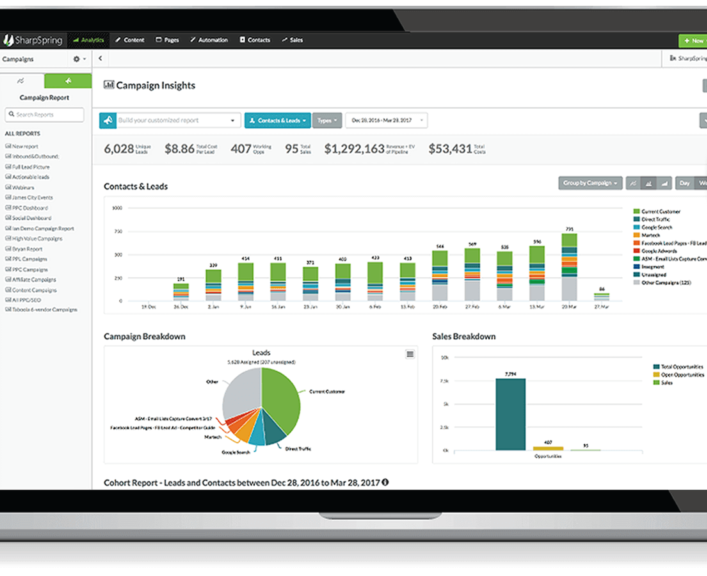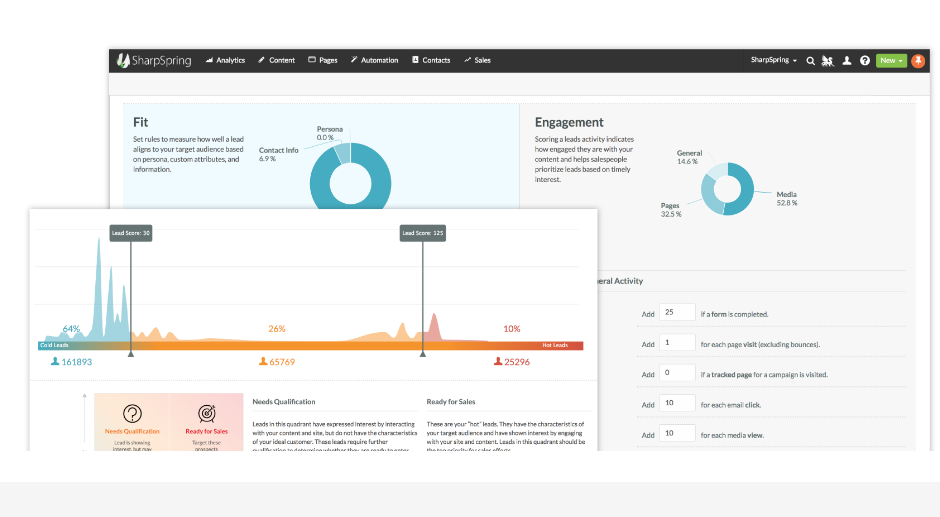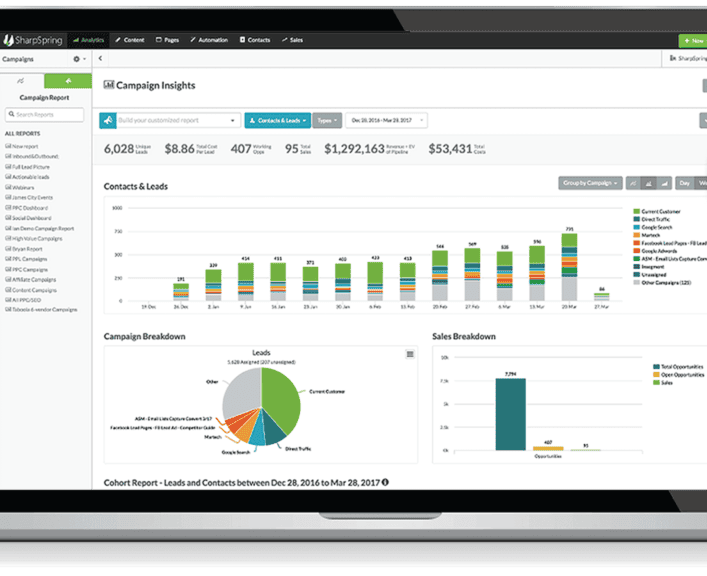Marketing automation can do many different things to benefit your business, but how does it actually work?
We will explore how marketing automation works in general, and how the different features can be applied to your business to help you streamline your processes and generate more future business.
What is marketing automation?

Marketing automation is any system or software that can streamline or automate marketing tasks and workflows. This helps key marketing channels operate faster via automations, and makes measuring the performance of the marketing channels much simpler.
At Xanthos, we use SharpSpring, and SharpSpring themselves define it in the following way:
Marketing automation refers to software platforms that help businesses automate their marketing and sales engagement processes to generate more leads, convert more leads to sales, and optimize ROI. Marketing automation allows marketers to automate repetitive tasks such as sending emails, maintaining social media, tracking website interactions, and managing various other tasks. Marketing automation centralizes all of the features and functions that make up the marketer’s role in an organization. A marketing automation platform should have the ability to integrate with other sales & marketing tools (CMS, CRM, social media, meeting software, etc.) to provide a centralized platform for data management and analysis.
SharpSpring – Marketing automation in a nutshell
What does marketing automation do?
At a high level, marketing automation helps you to:
- Drive more leads into marketing funnels
- Convert more leads into sales
- Optimise your marketing spend
- Optimise marketing performance
- Generate more revenue
80% of marketing automation users have seen leads increase, with 77% of marketing automation users seeing an increase in conversions.
Marketing automation uses cookies to track users around your site, and once they engage with an email or a form, the software can then add the cookie data to a name and you can see everything that is going on.
In doing so, this means you can set rules up in the software. This takes the form of workflows, so you can put in any combinations to suit your needs, and it will continually run these workflows when people take the actions you specify, or meet criteria you have laid out.
So how does marketing automation actually work?
You will likely know what actions you want people to take, and what actions visitors to your site in general take. But you won’t know what actions specific people are taking, and following up with them.
With marketing automation, you can do this. Instead of sending out a generic email blast to thousands of contacts and hoping a percentage of those click through and a further percentage of those will take an action on your site, you can create interconnected campaigns to engage individual leads or potential customers.
This allows you to create campaigns that help acquire new customers, retain existing customers, reengage current contacts, find opportunities for cross-selling and upselling, and in general keep people engaged with your brand.
So while you can still send out email campaigns en masse to your database of contacts, you can follow this up with targeted campaigns. The focus of marketing automation is on the specific, personalised, automated emails that will form your strategy.
Rather than assuming what people are interested in and want from you, you can send them content or emails that are tailored to what they look at on your site, or the content they engage with. You need to think about how you can best engage with specific people or personas rather than hitting and hoping. This leads to much better performance from your campaigns.
The most important element here, is that even if you currently knew who was doing what on your site, you would manually have to email them. Marketing automation means you set up one email template, and it will send the email when someone takes a particular action. It will be personalised to come from you and include their name. And you won’t have to lift a finger once it is initially set up.

So if you sent out an email with links to content and a download, you would be able to see who clicks on which link, the content they view, and whether they sign up using the integrated form. If they didn’t sign up for the download, you could follow-up only with the people who didn’t sign up, rather than emailing everyone once again. Similarly, if you have follow-up content on similar topics to the content in the first email, you can segregate your marketing emails to target this content. So the people who click the first link would receive an email with more in-depth information on that specific topic, while people who clicked the second link on another topic would receive an alternative email. And so on.
For instance, you can tell the marketing automation software to add all existing users and future users to a list IF they have visited a series of 3 blog posts, or product pages, that suggest they are interested in what you have to offer. Then, you can have it send out a series of 5 emails with a set time in-between, to hope to engage them regarding the product they are interested in. You can see which emails they open, and even set up alerts for when people visit certain pages to alert your sales team that a lead is currently hot. This is just one example, but there are countless ways to combine the options.
What features does marketing automation offer?
Marketing automation offers many, many features, but a few of the more important ones are below.
Email automation
Send out automated email messaging when potential customers take actions. For instance, send a series of personalised emails to someone who fills out a form, or follow up leads who visit particular pages on your site with an email.
CRM
Marketing automation includes an integrated customer relationship manager system so you can monitor what people are looking at and how they are engaging. For instance, you can see all the emails you have sent to an individual contact, when they opened it, and which links they click. Not only that, but you can also see the pages on the site they visit at any time.

Dynamic content
Create an email template and the software will personalise certain elements based on the contact it is being sent to. This goes beyond simply changing names but can differ on personas you can set up.
Lead scoring
Set up an initial set of rules of what makes a good lead, and have all your contacts and leads scored on this basis. This way, when you log into the system, your sales people can see which leads they should be contacting straight away, and which others may not be as worth the time.
Landing page builder
Marketing automation software also allows you to simply generate landing pages so you can quickly spin up optimised pages to get potential customers to fill the top of your marketing funnel. This could be a sign-up form for a whitepaper, or a new product launch. There will be a template to suit your needs.
Sales pipeline
Not only does marketing automation help your marketing processes, it also helps to visualise and streamline your sales process. You can open up opportunities, and track their progress. This can be seen in a visual sales pipeline to see where you can improve and how to make the most of your opportunities that crop up. This means you can see where your opportunities arise from in the marketing channels too.
End-to-end reporting and analytics
Marketing automation offers a simple website analytics feature that helps you see what is going on at a glance, but it also offers more in-depth reporting of other aspects. This can drill down into which marketing channels are performing best, where you get your revenue from, and the ROI of your marketing efforts.













